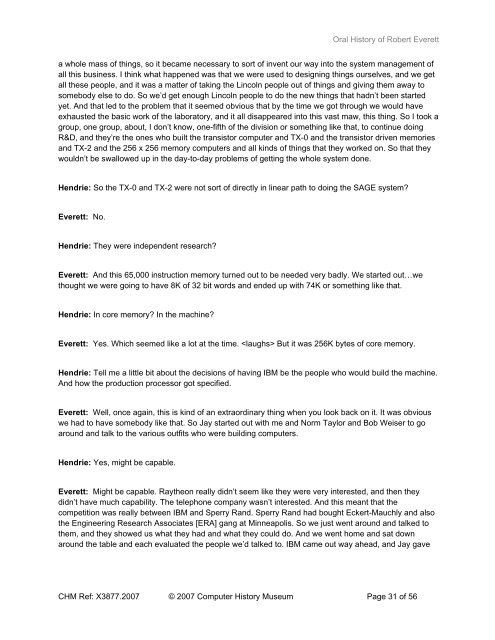Oral History of Robert Everett - Computer History Museum
Oral History of Robert Everett - Computer History Museum
Oral History of Robert Everett - Computer History Museum
You also want an ePaper? Increase the reach of your titles
YUMPU automatically turns print PDFs into web optimized ePapers that Google loves.
<strong>Oral</strong> <strong>History</strong> <strong>of</strong> <strong>Robert</strong> <strong>Everett</strong><br />
a whole mass <strong>of</strong> things, so it became necessary to sort <strong>of</strong> invent our way into the system management <strong>of</strong><br />
all this business. I think what happened was that we were used to designing things ourselves, and we get<br />
all these people, and it was a matter <strong>of</strong> taking the Lincoln people out <strong>of</strong> things and giving them away to<br />
somebody else to do. So we’d get enough Lincoln people to do the new things that hadn’t been started<br />
yet. And that led to the problem that it seemed obvious that by the time we got through we would have<br />
exhausted the basic work <strong>of</strong> the laboratory, and it all disappeared into this vast maw, this thing. So I took a<br />
group, one group, about, I don’t know, one-fifth <strong>of</strong> the division or something like that, to continue doing<br />
R&D, and they’re the ones who built the transistor computer and TX-0 and the transistor driven memories<br />
and TX-2 and the 256 x 256 memory computers and all kinds <strong>of</strong> things that they worked on. So that they<br />
wouldn’t be swallowed up in the day-to-day problems <strong>of</strong> getting the whole system done.<br />
Hendrie: So the TX-0 and TX-2 were not sort <strong>of</strong> directly in linear path to doing the SAGE system?<br />
<strong>Everett</strong>: No.<br />
Hendrie: They were independent research?<br />
<strong>Everett</strong>: And this 65,000 instruction memory turned out to be needed very badly. We started out…we<br />
thought we were going to have 8K <strong>of</strong> 32 bit words and ended up with 74K or something like that.<br />
Hendrie: In core memory? In the machine?<br />
<strong>Everett</strong>: Yes. Which seemed like a lot at the time. But it was 256K bytes <strong>of</strong> core memory.<br />
Hendrie: Tell me a little bit about the decisions <strong>of</strong> having IBM be the people who would build the machine.<br />
And how the production processor got specified.<br />
<strong>Everett</strong>: Well, once again, this is kind <strong>of</strong> an extraordinary thing when you look back on it. It was obvious<br />
we had to have somebody like that. So Jay started out with me and Norm Taylor and Bob Weiser to go<br />
around and talk to the various outfits who were building computers.<br />
Hendrie: Yes, might be capable.<br />
<strong>Everett</strong>: Might be capable. Raytheon really didn’t seem like they were very interested, and then they<br />
didn’t have much capability. The telephone company wasn’t interested. And this meant that the<br />
competition was really between IBM and Sperry Rand. Sperry Rand had bought Eckert-Mauchly and also<br />
the Engineering Research Associates [ERA] gang at Minneapolis. So we just went around and talked to<br />
them, and they showed us what they had and what they could do. And we went home and sat down<br />
around the table and each evaluated the people we’d talked to. IBM came out way ahead, and Jay gave<br />
CHM Ref: X3877.2007 © 2007 <strong>Computer</strong> <strong>History</strong> <strong>Museum</strong> Page 31 <strong>of</strong> 56















